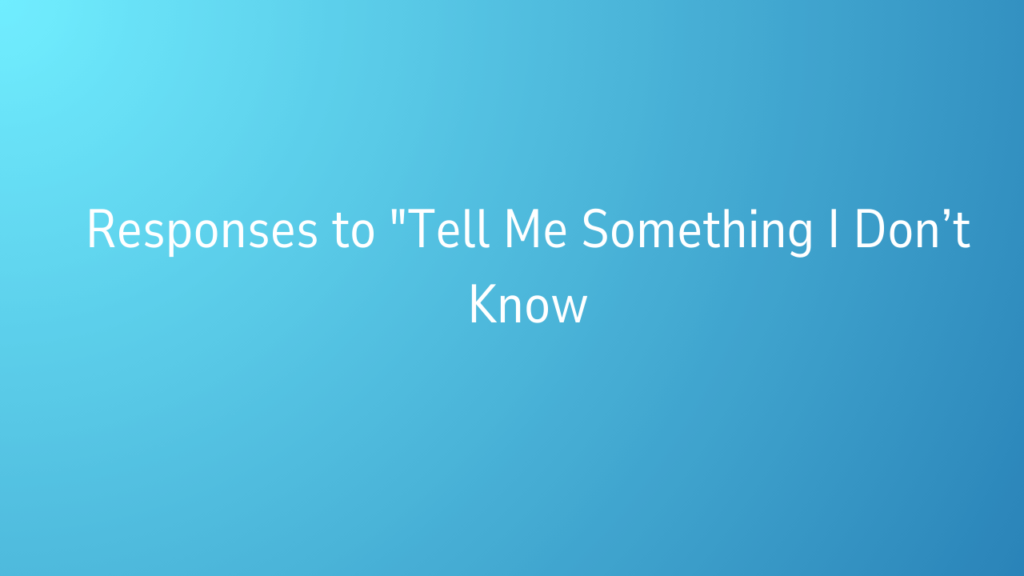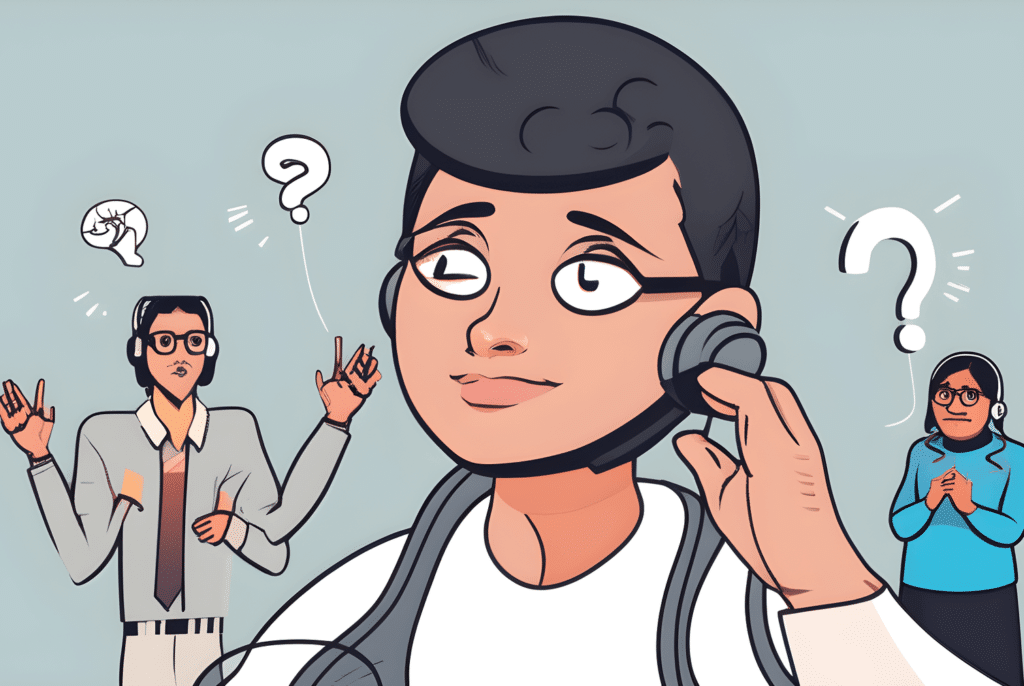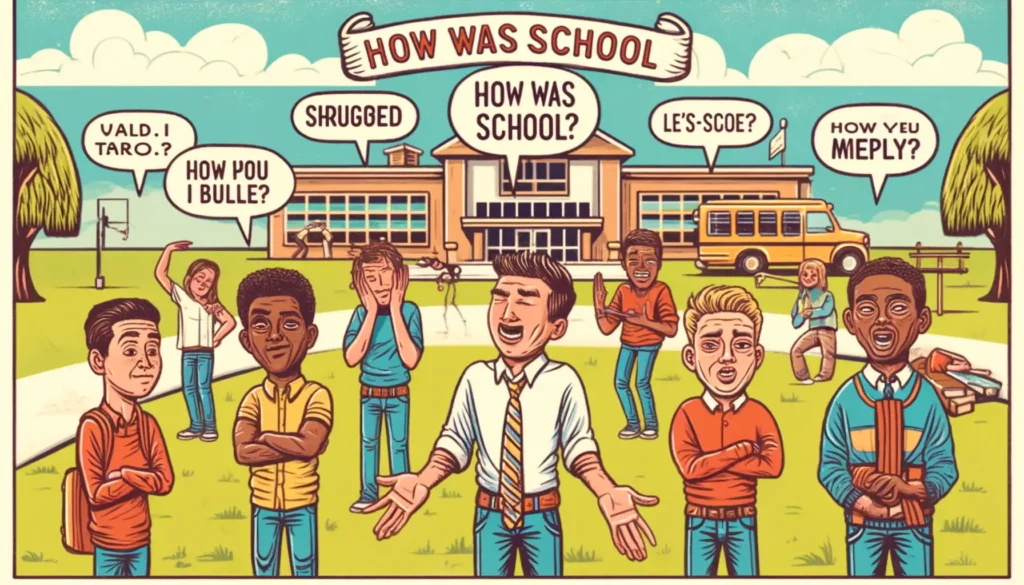We’ve all been there — you’re in a conversation, and someone hits you with the challenge, “Tell me something I don’t know.” Whether it’s a casual chat with a friend, a date, or a social media conversation, this request can catch you off guard. It’s a fun way for people to spark curiosity and make the interaction more engaging. The pressure, however, is real. You might feel the need to come up with something interesting, unique, or impressive, but don’t worry, we’ve got you covered!
In this blog post, we’ll explore the different types of responses you can give when someone asks you to tell them something they don’t know. From fun facts to humorous quips and mind-blowing information, we’ll guide you through some of the best ways to keep the conversation interesting, fun, and informative. Whether you want to impress your friends, make someone laugh, or start a deep conversation, we’ll cover it all.
Why Do People Ask, “Tell Me Something I Don’t Know”?
Before we dive into different responses, let’s take a moment to understand why someone might ask this question. Here are a few reasons:
- Curiosity: They want to learn something new, something they haven’t heard before.
- Challenge: They might be testing your knowledge, or trying to impress you with an unexpected piece of information.
- Boredom: Sometimes people ask this when they’re simply looking for a fun and engaging conversation.
- Trying to Connect: They could be using this as a way to deepen the conversation or bond with you.
Now that we know the “why” behind the question, let’s explore some great responses.
Responses to “Tell Me Something I Don’t Know”
1. Fun Facts
Everyone loves learning something new, and fun facts are a great way to keep the conversation light and engaging. These interesting tidbits are sure to impress and get people talking.
Example Fun Facts:
- “Did you know that a group of flamingos is called a ‘flamboyance’?”
- This quirky piece of information is both fun and memorable. It’s also a conversation starter!
- “Honey never spoils. Archaeologists have found pots of honey in ancient tombs that are still good to eat.”
- A surprising fact that could spark a deeper conversation about food preservation or archaeology.
- “Bananas are berries, but strawberries aren’t. Crazy, right?”
- A fact that might confuse but definitely intrigues the listener.
- “There’s a species of jellyfish known as Turritopsis dohrnii that is biologically immortal.”
- An impressive scientific fact that’s sure to capture attention.
- “Octopuses have three hearts and blue blood.”
- A mind-boggling and interesting fact about sea life.
Why Fun Facts Work:
- Engaging: Fun facts are short, interesting, and can easily spark curiosity.
- Memorable: Most people don’t know these facts, so they’ll stick with your audience.
- Easy to Share: Fun facts can be repeated in later conversations, making you sound knowledgeable.
2. Humorous Responses
If you’re looking to keep the conversation lighthearted and fun, humor is always a great option. A funny, quirky response will show your playful side and keep the interaction engaging.
Example Humorous Responses:
- “I’m pretty sure I know how to perfectly procrastinate. I’ll let you know the secret when I actually get around to it.”
- A funny, self-deprecating response that showcases your sense of humor.
- “I once tried to teach my cat how to play the piano. It didn’t go well.”
- A humorous anecdote that adds personality to your response.
- “I could tell you something you don’t know, but where’s the fun in giving away all my secrets?”
- A playful and teasing way to avoid giving a straight answer while still keeping the conversation going.
- “I know how to make the perfect cup of coffee. Too bad I can’t make one for you through the phone!”
- A lighthearted response that also hints at your “skills.”
- “Did you know that 90% of the time, I’m just making it up as I go? This is one of those times!”
- A humorous admission that adds some charm and wit to the conversation.
Why Humor Works:
- Creates Connection: Humor helps people bond over shared laughter.
- Relieves Tension: A humorous response can break the ice if the conversation is getting too serious.
- Keeps Things Light: Humor keeps the mood upbeat and makes it easy to navigate awkward silences.
3. Mind-Blowing Information
If you really want to leave your audience amazed, hit them with some mind-blowing or surprising knowledge. These types of responses can turn a simple question into a memorable moment.
Example Mind-Blowing Responses:
- “The Eiffel Tower can grow by up to 6 inches during the summer due to the expansion of the metal.”
- A surprising fact that not only teaches something new but also adds a layer of curiosity about how things work in the real world.
- “There are more stars in the universe than there are grains of sand on all the beaches on Earth.”
- A huge concept that will leave anyone in awe and provoke deep thinking.
- “Sharks have been around longer than trees. They’ve existed for over 400 million years.”
- A piece of information that challenges perceptions and gets people thinking about the ancient past.
- “Wombats produce cube-shaped poop, which helps it not roll away!”
- A quirky fact that combines humor with a surprising biological detail.
- “You have more bacteria in your body than human cells. You’re technically more bacteria than human!”
- A fact that might make people rethink their own body in a fun and engaging way.
Why Mind-Blowing Facts Work:
- Captivates Attention: These responses are sure to get someone’s attention and spark further conversation.
- Unique: You’re likely to be one of the few people who shares this knowledge, making it memorable.
- Conversation Starters: Mind-blowing facts often lead to deeper discussions or new questions.
4. Historical or Cultural Insights
If you have a knack for history or enjoy learning about other cultures, you can share some historical or cultural insights that might surprise your conversation partner.
Example Historical/Cultural Insights:
- “In ancient Rome, it was considered a sign of wealth to have a vomitorium in your home, but it wasn’t a place to vomit. It was actually a hall designed for crowds to exit the amphitheater quickly!”
- A surprising historical fact that reveals how misunderstandings or myths can arise from language and culture.
- “Did you know Cleopatra wasn’t Egyptian? She was actually Greek and came from the Ptolemaic dynasty of Macedonian descent.”
- A historical tidbit that challenges common misconceptions about one of history’s most famous figures.
- “The shortest war in history was between Britain and Zanzibar on August 27, 1896. It lasted just 38 minutes!”
- A fascinating and little-known historical fact that’s sure to spark conversation.
- “In Japan, there’s a tradition where people celebrate ‘Hanami’ by watching cherry blossoms bloom. It’s a whole cultural event about appreciating the fleeting beauty of life.”
- A beautiful cultural fact that could lead to a deeper conversation about traditions.
- “In 1815, the eruption of Mount Tambora in Indonesia caused the ‘Year Without a Summer’ in 1816, leading to widespread crop failures and famines in the Northern Hemisphere.”
- A fascinating piece of history that also shows the interconnectedness of global events.
Why Cultural/History Insights Work:
- Expands Knowledge: Sharing cultural or historical facts provides insight into different places, people, and events.
- Creates Depth: These types of facts can lead to rich discussions about traditions, events, and global history.
- Makes You Look Cultured: Sharing uncommon historical or cultural knowledge can make you come across as worldly and well-read.
5. Personal and Relatable Responses
Sometimes, a personal or relatable response can be a great way to share something that others might not know about you specifically. These responses provide a more intimate look into your life.
Example Personal Responses:
- “I can quote almost every line from ‘The Office,’ but I swear I’m not obsessed… Okay, maybe a little.”
- A personal tidbit that could spark a discussion about favorite shows or guilty pleasures.
- “I can fall asleep anywhere. I once took a nap in an airport lounge with people walking all around me.”
- A quirky personal fact that may prompt others to share their own funny or surprising experiences.
- “I’m secretly really good at cooking, but I only make food for special occasions!”
- A fun and personal response that gives insight into a hobby or skill you have.
- “I’ve always wanted to try skydiving, but I’m too scared of heights. One day, though!”
- A personal admission that shows vulnerability while also inviting the other person to share their own fears or aspirations.
- “I once did a whole workout routine with socks on, and I’m still not sure how I didn’t slip and fall!”
- A humorous and relatable response that invites laughter and possibly a conversation about other funny incidents.
Why Personal Responses Work:
- Builds Connection: Sharing something personal helps you connect with others on a deeper level.
- Encourages Reciprocity: Your personal response might prompt the other person to share their own quirky or interesting facts.
- Adds Personality: Personal responses give a glimpse into your unique traits, making the conversation more meaningful.
Conclusion
“Tell me something I don’t know” can be a fun and engaging question that opens up many possibilities for conversation. Whether you’re dropping a fun fact, cracking a joke, sharing a historical tidbit, or revealing something personal, your response can leave a lasting impression.
Remember, the key to handling this question is to stay confident and creative. Don’t feel pressured to come up with an answer immediately — take a moment to think of something interesting and relevant to the conversation. Whether you’re aiming to impress, entertain, or inform, these responses will help you handle the question like a pro.



